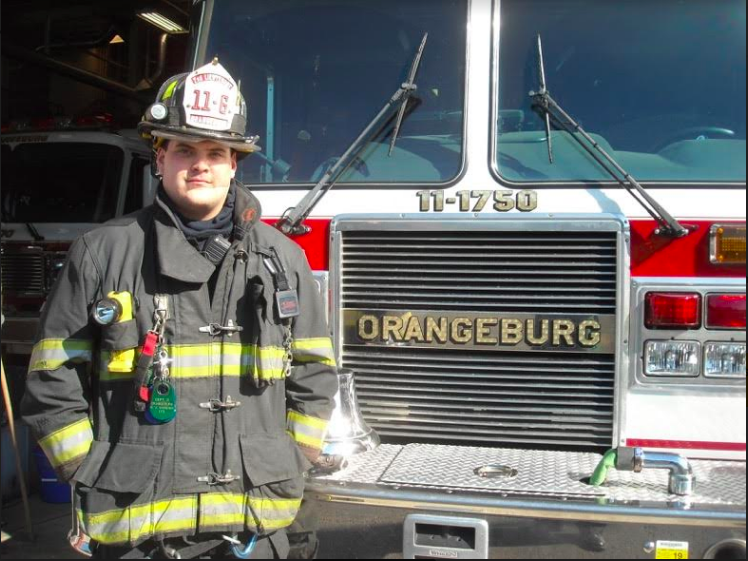
By Barry Warner
Emergency calls can come in at any time of the day or night and must be dealt with immediately. Firefighters must be experts in getting themselves dressed in the appropriate gear and mounting the emergency vehicles quickly. These emergency calls can involve a host of challenges including structure fires, auto accidents, brush fires and other hazardous situations.
“I have been a firefighter for six years and currently, I’m serving as a 2nd Lieutenant. I’m in charge of the air packs, radios and pagers. If a new member needs gear, I make sure it fits properly and is ready for use. I have taken the New York State Hazmat Technician course. I am in charge of fire ground training and drill nights,” Gordon told the Rockland County Times. “Last night we went over air management with the Self-Contained Breathing Apparatus (SCBA). I made sure that the bottles were full of compressed air, the batteries were okay and all the straps were good. In the event of a fire, I receive information on my pager, listen to what it is, come down here to the firehouse, put on my gear, wait for the guys and get up front to drive the tanker truck. I went through EVOC and Pump Ops training to be qualified. I learned how to pump water at any level when going into a building, how to deal with a loss of water pressure and what to do if a hose line breaks. On the fire ground, the chiefs give me instruction, I relay it to my guys, we get the job done and then let the chiefs know that the task is completed.”
“Three weeks ago, there was a rollover on Route 303,” Gordon continued. “We had to take the roof off to get the patient out. We now have a new ‘Jaws of Life,’ which is a battery-powered e-DRAULIC device. From arriving on the scene, we had the patient out in six minutes and on the way to the hospital. It was fantastic! Many of our calls involve the Rockland Psychiatric Center, a senior citizen complex and the commercial warehouses on route 303. For instance, if the alarm at the senior complex is for burnt food, we check out the residence, bring in a fan to clear the smoke out and silence the smoke alarm.”
The fire pumper or engine carries 500 gallons of water for a quick attack on a fire until a dedicated water supply can be established from a fire hydrant. The firefighters connect the hoses to the water source using various tools. They get the hoses into position by dragging, carrying or hoisting them into place. Training procedures include removing the right amount of hose from the pumper, carrying the hose effectively on the shoulder or arm, flaking or stacking the hose line, staging enough hose at the entrance point of the structure, coupling the nozzle for the lead-line advance, knowing when to charge the line with water and donning personnel protective equipment (PPE), such as the mask, hood, helmet and gloves.
The Emergency Vehicle Operator Course (EVOC) explains the importance of emergency vehicle driving, the hazards of intersections and the risks of backing-up the apparatus. Also, the course focuses on the different weight distribution factors, the center of gravity when driving the fire truck and the steps to prevent emergency vehicle roll over. Defensive driving techniques include space management, following distance and rate of closure, hazard identification plus braking techniques.
Automotive design changes have increased the frequency of vehicle rollovers in which the vehicle ends up resting on its roof with the patients still belted in their seats. Vehicle manufacturers have engineered more aerodynamic vehicles to increase fuel efficiency, with a more rounded, streamlined appearance in contrast to the boxy shape of older cars. As a result, when a vehicle rolls, it tends to roll over more times and comes to rest on the flat roof section than on the rounded sides. eDRAULICS is a technology developed for rescue equipment, such as the ‘Jaws of Life,’ based on the principle of electro-hydraulics, where electrical energy is converted into a hydraulic force. eDRAULIC tools have the same force as the corresponding hose-connected tools. They require no hoses or power units. Because these tools are stronger and lighter, rescues take less time to be accomplished. Hydraulics is the science of transmitting force and motion through the medium of a confined liquid. The transfer of energy takes place because a quantity of liquid is subject to pressure.
“Volunteering as a firefighter has been a great experience,” Gordon concluded. “I made a lot of friends, and had fun and participated in many events, such as the Halloween and Christmas parades. Many of the people in my family served as firefighters or were on the police force. Growing up I enjoyed being in the firehouse with my dad and my cousins. I enjoy giving back and I know that the people in our community appreciate our efforts.”
For information about volunteering, please visit www.orangeburgfd.org or call 845-359-5587.

You must be logged in to post a comment Login